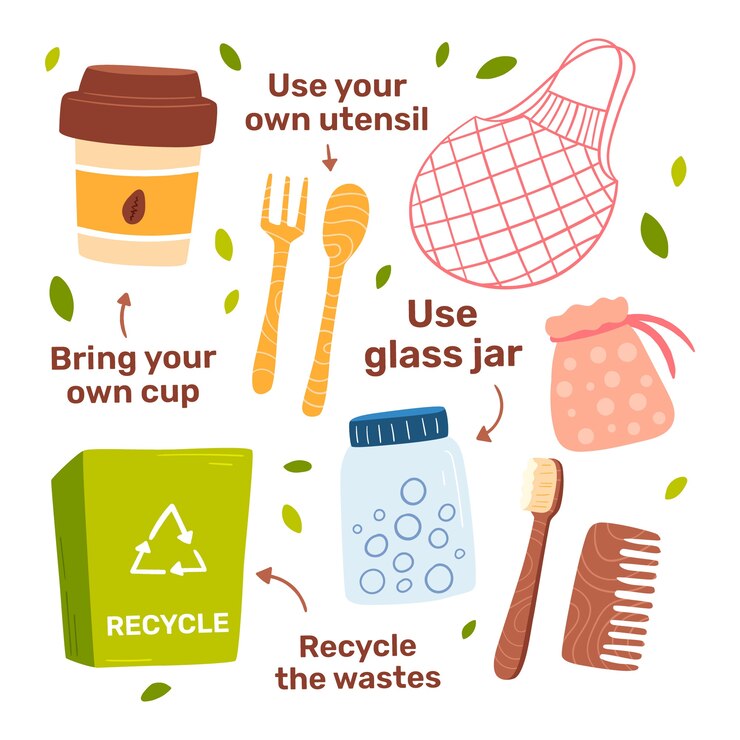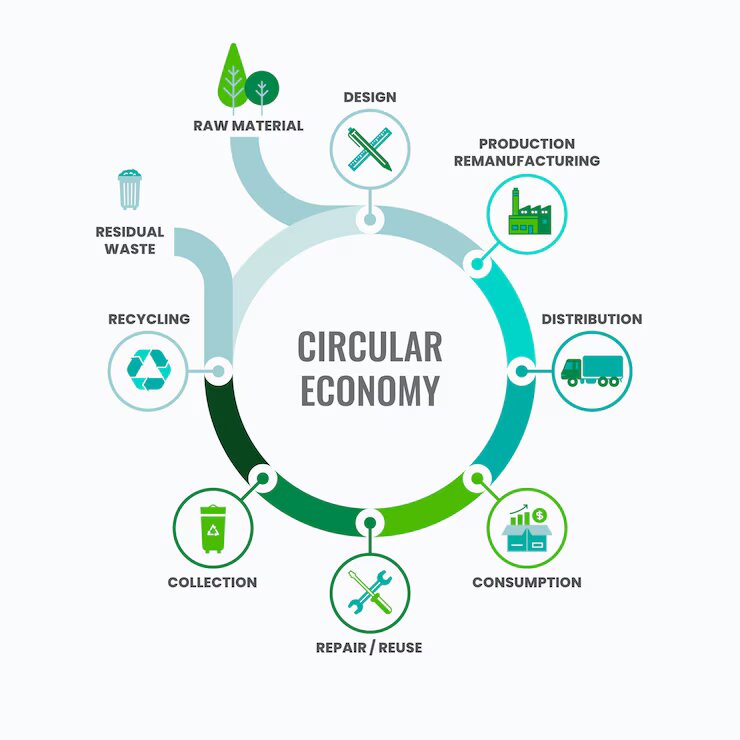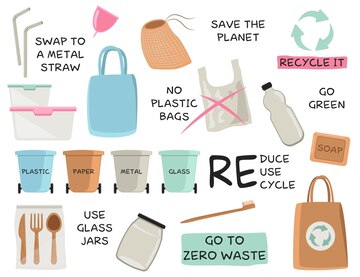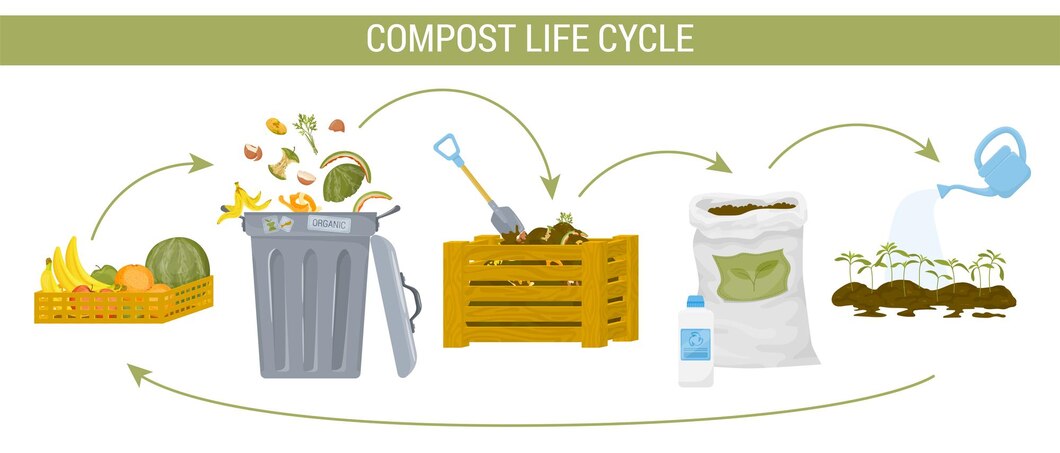10 Effective Ways to Adopt a Zero-Waste Lifestyle: Tips, Expert Insights, and Sustainable Practices
Let’s talk about adopting a zero-waste lifestyle, a sustainable effort to reduce the amount of waste in landfills and oceans. It is said that the average person generates over 700 kilograms (1,543.2 pounds) of waste each year. Our throwaway culture, trends promoting fast fashion, and reliance on single-use plastics are among the factors contributing to waste pollution. In this guide, we will explore practical steps, expert insights, real-world examples, and the broader impact of zero-waste living.

In This Article
- The Global Waste Crisis: Understanding the Scale of the Problem
- Why Adopt a Zero-Waste Lifestyle?
- How to Transition to a Zero-Waste Lifestyle
- Zero-Waste Challenges and How to Overcome Them
- Working Towards a Zero-Waste Future
- Future Trends in Zero-Waste Living
- Conclusion
The Global Waste Crisis: Understanding the Scale of the Problem
The amount of waste generated globally is estimated to exceed 2 billion tons of municipal waste annually, with only 13.5% recycled and 5.5% composted. The rest ends up in landfills or is incinerated, leading to air pollution that poses a threat to human health. According to a report by the World Bank, if current waste management practices continue, global waste will increase by 70%, reaching 3.4 billion tons per year by 2050.
Table 1: Global Waste Generation and Management (2018 Data)
| Region | Waste Generated (Million Tons) | Recycling Rate (%) | Composting Rate (%) | Landfill Rate (%) | Incineration Rate (%) |
| East Asia & Pacific | 468 | 25 | 6 | 54 | 15 |
| Europe & Central Asia | 392 | 30 | 9 | 40 | 21 |
| Latin America & Caribbean | 231 | 4 | 1 | 90 | 5 |
| Middle East & North Africa | 129 | 6 | 2 | 69 | 23 |
| North America | 289 | 35 | 8 | 55 | 2 |
| South Asia | 334 | 4 | 2 | 81 | 13 |
| Sub-Saharan Africa | 174 | 4 | 2 | 80 | 14 |
The Great Pacific Garbage Patch
The Great Pacific Garbage Patch offers only a glimpse of the extent of plastic pollution in the ocean. According to a study published in Nature, it covers an estimated surface area of 1.6 million square kilometres and contains about 79,000 tons of plastic debris. The patch is primarily composed of microplastics smaller than 5 millimetres, which pose the greatest threat to marine life
Dr. Jenna Jambeck, an environmental engineer at the University of Georgia, explains, “The Great Pacific Garbage Patch is not just a floating island of plastic. It’s a complex and dynamic system where plastics break down into smaller particles, becoming more difficult to clean up and more dangerous to marine organisms.”
The Impact of Plastic on Marine Life
It’s estimated that over 700 marine species, especially endangered ones, are affected by plastic pollution. A report by National Geographic suggests that 90% of seabirds have traces of plastic in their stomachs. Fish, turtles, and whales ingest this plastic debris, mistaking it for food, which often leads to intestinal blockage, malnutrition, and even death. Plastic pollution in the ocean also finds its way into the food chain, affecting human health as well.
Why Adopt a Zero-Waste Lifestyle?
Adopting a zero-waste lifestyle promotes healthy living, environmental sustainability, and reduces pollution. According to a study by the Ellen MacArthur Foundation, transitioning to a circular economy, where waste is minimised and resources are reused, could reduce global greenhouse gas emissions by up to 39% by 2050.
Professor Michael Braungart, co-author of Cradle to Cradle: Remaking the Way We Make Things, explains, “The zero-waste concept is about designing products and systems that are beneficial to both humans and the environment. It’s not just about reducing waste but creating positive impacts.”

Economic and Social Benefits
The economic benefits of adopting a zero-waste lifestyle are substantial. A report by the World Economic Forum estimates that improving waste management practices could create over 14 million jobs globally by 2030. Within local communities, proper waste management can prevent the spread of diseases like diarrhoea and cholera.
Dr. Kate O’Neil, a professor at the University of California, Berkeley, and author of Waste, states, “The zero-waste movement is not just an environmental issue. It’s a socio-economic issue that can drive innovation, create jobs, and foster community resilience.”
How to Transition to a Zero-Waste Lifestyle
#1. Choose Reusable over Disposable

Switching to reusable products is one of the most effective steps toward transitioning to a zero-waste lifestyle. A study published in Environmental Research Letters explains that using a reusable shopping bag just 10 times reduces the carbon footprint of plastic bags by 90%.
Actionable Steps
- Reusable Bags and Containers: Choose sustainable options such as beeswax wraps, silicone storage bags, and glass containers for wrapping and storing food in your kitchen. These alternatives are far better than single-use plastics.
- Reusable Water Bottles and Cups: Purchase durable reusable containers from brands like Klean Kanteen and Hydro Flask. These brands offer high-quality products you’ll love to use.
- Zero-Waste Kit: A zero-waste kit comes with reusable straws, utensils, and napkins. These eco-friendly options help reduce the need for disposable items.
Case Study: San Francisco’s Reusable Bag Ordinance
In 2007, San Francisco banned the use of plastic bags, which resulted in a 72% reduction in plastic litter. The sustainable policy also saved retailers over $2.5 million annually since the ban took effect.
Learn More: Sustainable Ways to Get Rid of Your Clothes
#2. Reduce Food Waste
Food waste from kitchens is a significant problem in both developed and developing countries. According to the United Nations Food and Agriculture Organisation (FAO), an estimated one-third of all food produced for human consumption is wasted.
Actionable Steps
- Meal Planning: To avoid food spoilage, create a well-planned shopping list. Apps like Mealime and Paprika can help streamline the process.
- Proper Food Storage: Store perishable foods carefully to extend their shelf life. Keep leafy greens in breathable bags and store root vegetables in a cool, dark place.
- Use Leftovers: Incorporate leftovers into new recipes. Websites like Love Food Hate Waste offer creative ideas on how to use leftovers.
A study published in Resources Conservation and Recycling found that improved food storage and meal planning could reduce household food waste in the United States by up to 30%.

#3. Adopt a More Sustainable Laundry Routine
Your choice of laundry products, fabrics, and water usage can impact the environment. According to a report by the American Cleaning Institute, washing clothes in cold water can reduce energy consumption by up to 90%.
Actionable Steps
- Eco-Friendly Detergents: The best products for your laundry are eco-friendly detergents free of phosphates and synthetic fragrances. Brands like Ecover and Seventh Generation offer great eco-friendly detergent options.
- Cold Water Washing: Washing clothes in cold water preserves fabric quality and saves energy.
- Air Drying: Air drying your clothes extends the life of the garments and also consumes less energy.
According to Dr Mark Anthony Browne, a marine researcher, “Microfibers from synthetic clothing are a major source of microplastic pollution. Reducing washing frequency and choosing natural fibres can significantly lower this impact.”

#4. Composting
Composting transforms organic waste, which would otherwise end up in landfills, into organic fertiliser, ideal for growing fresh food and vegetables. According to the U.S. Environmental Protection Agency (EPA), composting reduces the need for synthetic chemical fertilisers and enhances soil health.
Actionable Steps
- Start Composting at Home: Convert organic waste into rich compost using a bin or vermicomposting system for small items. Add fruit and vegetable scraps, eggshells, coffee grounds, and yard waste to the compost bin.
- Community Composting: If you don’t have space for a compost bin, check with your community for composting programs or drop-off sites.
Case Study: San Francisco’s Mandatory Composting Law
In 2009, San Francisco became the first U.S. city to mandate composting. This initiative helped the city divert about 80% of its waste from landfills.

#5. Avoid Using Plastic
Plastic pollution remains a serious environmental issue. According to a report by the Pew Charitable Trusts, the amount of plastic in the ocean will nearly triple by 2040 if actionable measures to prevent further pollution are not prioritised.
Actionable Steps
- Plastics-Free Alternatives: Avoid using or bringing plastics into your home. Opt for reusable options such as bamboo utensils, toothbrushes, stainless steel straws, and glass storage containers.
- Zero-Waste Shopping: Shop at bulk stores that allow consumers to bring reusable bags or containers. Always purchase eco-friendly products with certified labels.
Dr Jenna Jambeck, co-creator of the Plastic Waste Input Model, states, “To tackle plastic pollution, we need systemic change in how we produce, consume, and manage plastics. Individual actions, while important, must be supported by strong policies and industry innovations.”

Learn More: How to Make Your House More Sustainable
#6. Buy Secondhand
Buying secondhand products is often overlooked as being cheap and lacking quality; however, it remains one of the most effective ways to reduce waste and conserve resources. According to a report by ThredUp, the secondhand market is expected to double in value by 2025, reaching an impressive $77 billion.
Actionable Steps
- Thrift Stores and Online Platforms: Secondhand products are available at local thrift stores and on online platforms such as eBay, Poshmark, and ThredUp.
- Repair and Upcycle: Instead of discarding broken items, try repairing or repurposing them to give them a new life.
Case Study: Patagonia’s Worn Wear Program
Patagonia’s Worn Wear program encourages consumers to buy, sell, and trade used Patagonia gear. This initiative promotes a circular economy and has extended the life of over 100,000 products.

#7. Choose a Sustainable Transportation Option
Transportation by gasoline and diesel-powered vehicles generates huge amounts of CO2 emissions—it’s responsible for 25% of global carbon emissions. Adopting a zero-waste lifestyle also includes choosing green transportation options. Consider taking a bus, riding a bike, or walking short distances to reduce your carbon footprint.
Actionable Steps:
- Biking and Walking: Biking or walking is healthier and more environmentally friendly than driving. Apps like “Strava” can help you track your rides and walks.
- Public Transportation: Opt for a bus or train instead of driving. Many cities offer apps that provide real-time information on public transit options.
- Electric Vehicles: The future lies in electric vehicles with zero carbon emissions. According to the International Energy Agency (IEA), electric vehicles lower emissions over their lifetime compared to conventional cars.
Professor Daniel Sperling, director of the Institute of Transportation Studies at the University of California, Davis, states, “Transitioning to sustainable transportation is essential for reducing emissions and improving urban air quality. Policies that support public transit and active transportation are key to this shift.”

#8. Go Paperless
Adopting a zero-waste lifestyle also involves going paperless. Paper production is resource-intensive and a huge contributor to deforestation and pollution. Although paper is recyclable, going paperless reduces overall trash output and increases sustainability.
Actionable Steps:
- Digital Alternatives: Use digital tools like Google Drive, Dropbox, and e-signature services to manage documents electronically.
- E-Statements and Bills: Opt for electronic statements and bills to reduce paper clutter and minimise your carbon footprint.
A study by the Environmental Paper Network found that reducing global paper consumption by 10% could save over 1.6 billion trees annually.

#9. Buy In Bulk
Buying in bulk while shopping not only reduces packaging waste but also saves you money. According to a study published in the Journal of Industrial Ecology, buying in bulk can lower the carbon footprint of products by up to 26%.
Actionable Steps
- Bulk Food Stores: Shop at bulk food stores that allow consumers to bring their own containers.
- Household Items: Purchase household items, such as personal care and cleaning products, in bulk to reduce packaging waste and minimise trips to the store.
Dr Anne-Marie Bonneau, known as the “Zero Waste Chef,” states, “Buying in bulk not only reduces packaging waste but also encourages mindful consumption. It’s a simple yet effective way to cut down on unnecessary purchases.”

#10. Reuse Common Household Items
Before discarding broken or old household items, consider ways they can be repurposed or upcycled. Reusing common household items not only reduces waste but also inspires creativity.
Actionable Steps
- Upcycle Projects: Repurpose old jars into planters or storage containers. Use old fabric scraps to make customised reusable clothes or bags.
- Community Swaps: Organise or participate in community swaps where you can exchange old items for something more useful.
Case Study: Repair Cafés
Repair Cafés originated in the Netherlands and offer free repair sessions where volunteers help fix broken items. This initiative has saved thousands of items from landfills and fostered a culture of repair and reuse.

Zero-Waste Challenges and How to Overcome Them
Common Obstacles
- Lack of Access to Zero-Waste Products: Many people don’t have access to zero-waste products or stores that sell in bulk, making it difficult to reduce packaging waste.
- Cost Barriers: Zero-waste products can be quite expensive, often exceeding the budgets of most people.
- Time Constraints: Activities such as preparing meals, making DIY products, and composting can be time-consuming.
Solutions
- Online Shopping: Explore online platforms specialising in zero-waste products, like EarthHero or Package Free Shop.
- Budget-Friendly Alternatives: Look for affordable options, such as repurposing old t-shirts into reusable cloths or using jars as storage containers.
- Simplify: Focus on high-impact changes, such as reducing food waste and using cost-effective reusable bags.
Working Towards a Zero-Waste Future
The Role of Policy and Innovation
Effective waste reduction requires sustainable, supportive policies and innovative technologies. Policies such as Extended Producer Responsibility (EPR), which hold manufacturers accountable for the entire lifecycle of their products, can significantly reduce packaging waste.
Dr William McDonough, co-author of Cradle to Cradle, emphasises, “Designing for a circular economy requires rethinking how we make and use products. Policies that promote this kind of thinking are essential for achieving a zero-waste future.”
Future Trends in Zero-Waste Living
- Biodegradable Innovations: Advances in materials science are leading to the development of biodegradable plastics and packaging—plastics made from plant-based materials such as algae and cornstarch.
- Circular Economy Initiatives: Companies like Loop are pioneering circular economy models, where everyday products are delivered in reusable packaging, reducing the need for single-use items.
- Digital Solutions: Apps and platforms that track waste, provide sustainable shopping options, and offer tips for zero-waste living are making it easier for individuals to adopt sustainable habits.
Conclusion
Embracing a zero-waste lifestyle is a journey that requires commitment and continuous learning. By making conscious choices—whether it’s choosing reusable products, reducing food waste, or supporting sustainable policies—we can all contribute to a healthier planet. The journey toward zero waste is a collective effort, requiring collaboration from individuals, communities, businesses, and governments. Together, we can create a sustainable future for generations to come.







